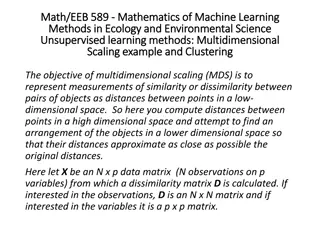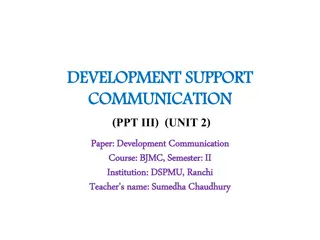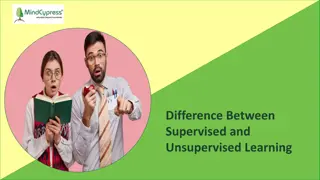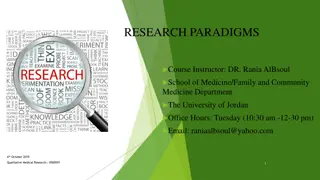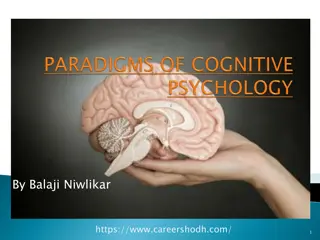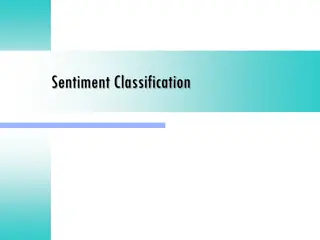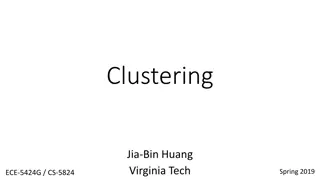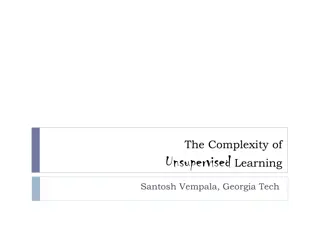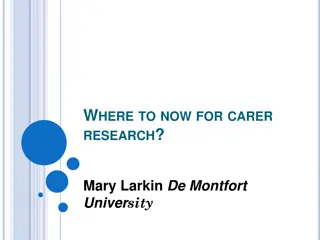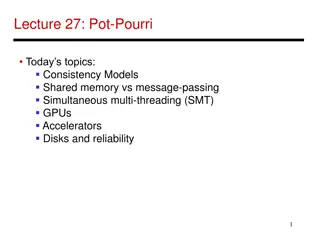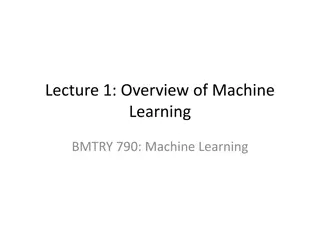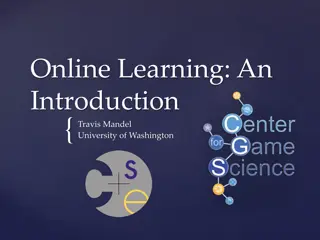Unsupervised Learning Paradigms and Challenges in Theory
Explore the realm of unsupervised learning as discussed in the Maryland Theory Day 2014 event. Overcoming intractability for unsupervised learning, the distinction between supervised and unsupervised learning, main paradigms, NP-hardness obstacles, and examples like the inverse moment problem are covered. Emphasizing the importance of making assumptions and simplifying problems to tackle challenges in the field.
Download Presentation

Please find below an Image/Link to download the presentation.
The content on the website is provided AS IS for your information and personal use only. It may not be sold, licensed, or shared on other websites without obtaining consent from the author.If you encounter any issues during the download, it is possible that the publisher has removed the file from their server.
You are allowed to download the files provided on this website for personal or commercial use, subject to the condition that they are used lawfully. All files are the property of their respective owners.
The content on the website is provided AS IS for your information and personal use only. It may not be sold, licensed, or shared on other websites without obtaining consent from the author.
E N D
Presentation Transcript
Maryland Theory Day 2014 Overcoming intractability for Unsupervised Learning Sanjeev Arora Princeton University Computer Science + Center for Computational Intractability (Funding: NSF and Simons Foundation)
Supervised vs Unsupervised learning Supervised: Given many photos labeled with whether or not they contain a face, generate labels for new photos. (STOC/FOCS: PAC learning. In ML: Support vector machines, online prediction, logistic regression, Neural nets etc ) Unsupervised: Use google news corpus to answer analogy queries King: Queen :: Waiter : ?? Unlabeled data >> labeled data. ( Big data world) CMU
Main paradigm for unsupervised Learning Given: Data Assumption: Is generated from prob. distribution with small # of parameters. ( Model ). HMMs, Topic Models, Bayes nets, Sparse Coding, Learning Find good fit to parameter values (usually, Max-Likelihood ) Difficulty: NP-hard in many cases. Nonconvex; solved via heuristics
Is NP-hardness an obstacle for theory? NP-hard instances (encodings of SAT) New York Times corpus (want thematic structure) Learning Topic Models Tractable subset??( Going beyond worst-case. Replacing heuristics with algorithms with provable bounds )
Example: Inverse Moment Problem X Rn : Generated by a distribution D with vector of unknown parameters A. For many distributions, A may in principle be determined by these moments, but finding it may be NP-hard. Recent progress: Can find A in poly time in many settings under mild nondegeneracy conditions on A. Tensor decomposition [Anandkumar, Ge, Hsu, Kakade, Telgarsky 2012]
Part 1: How to make assumptions and simplify problems. Example: Topic Modeling. (Unsupervised Method for uncovering thematic structure in a corpus of documents.) Goal: Algorithm that runs (under clearly specified conditions on input) in time polynomial in all relevant parameters, and produces solution of specified quality/accuracy.
Bag of words Assumption in Text Analysis . Banana 3 . . Snow 1 Soccer 0 = words = . . Walnut 5 Document Corpus = Matrix (ith column = ith document) .
Hidden Variable Explanation Document = Mixture of Topics . . . Banana 3 3% 0 . . . . . . Snow 1 Soccer 0 0 0 4% = 0.8 + 0.2 0 . . . . . . Walnut 5 5% 0
Hidden Variable explanation (geometric view) Topic 1 0.4 x Topic 1 + 0.3 x Topic 2 + 0.2 x Topic 3 Topic 2 Topic 3
Nonnegative Matrix Factorization (NMF) [Lee Seung 99] Given: Nonnegative n x m matrix M (all entries 0) W = A M NP-hard [Vavasis 09] Want: Nonnegative matrices A (n x r) and W (r x m), s.t. M = AW. (Aside: Given W, easy to find A via linear programming.) Applications: Image Segmentation, Info Retrieval, Collaborative filtering, document classification.
Separable Topic Matrices . . . . . . . . . . Banana 0 0 . . . . 0 . 0 . Snow 4% Soccer 0 0 8% . . . . . . . . . . . . Walnut 0 0 . .
Geometric restatement of NMF (after some trivial rescaling) Given n nonnegative vectors (namely, rows of M) Find r-dimensional simplex with nonnegative vertices that contains all. (rows of W = vertices of this simplex; Rows of A = convex combinations) Separable Vertices of simplex appear among rows of M
Finding Separable Factorization [A,Ge, Kannan, Moitra STOC 12] Algorithm: Remove a row, test if it is in the convex hull of other rows Case 1: Inside Row Can be represented by other rows Case 2: Row at a vertex Cannot be represented by other rows Robustly Simplicial Important: Procedure can tolerate noisy data if simplex is not too flat.
Learning Topic Models [Papadimitriou et al. 98, Hoffman 99, Blei et al. 03] Sampled from columns of A A W M Max-likelihood solution is NP- hard for adversarial data, even for r=2 (AGM 12) Topic matrix A (n x r) arbitrary, nonnegative. Stochastic W (r x m). Columns iid from unknown distrib. Given: M (n x m). ith column has 100 samples from distribution given by ith column of AW. Goal: Find A and parameters of distribution that generated W. Popular choice of distribution: Dirichlet. ( LDA Blei, Jordan, Ng 03.)
The main difficulty (why LDA learning NMF) . . Banana 3 Banana 0.03 . . . . NMF LDA Snow 1 Soccer 0 Snow 0.02 Soccer 0 X . . . . Small sample is poor representation of Walnut 5 Walnut 0.07 distribution; cannot be treated as noise .
Reducing topic modeling to NMF [A, Ge , Moitra FOCS 12] W Sampled from M A Word-word co-occurence matrix = MMT scaling) = AWnew where (2nd Moment) AWWTAT (up to Wnew = WWTAT Can factorize using noise tolerant NMF algorithm! Important: Need for separability assumption removed by [Anandkumar, Hsu, Kakade 12] (slower algorithm).
Empirical Results [A, Ge, Halpern, Mimno, Moitra, Sontag, Wu, Zhu ICML 13] 50x faster on realistic data sizes. Comparable error on synthetic data Similar quality scores on real-life data (NYT corpus). Works better than theory can explain.
Part 2: The unreasonable effectiveness of nonconvex heuristics.
Real life instances must have special structure Shrug.. Heuristics Theorist Branch & Bound for integer programming, DPLL-family for SAT solving/Software verification. Markov Chain Monte Carlo for counting problems (#P), Belief propagation for Bayes Nets,..
ML : Great setting to study heuristics Clean models of how data was generated Heuristics so natural that even natural systems use them (e.g., neurons). Theorists understand hardness; hence well-equipped to identify assumptions that provably simplify the problem.
Example 1: Dictionary Learning (aka Sparse Coding) Simple dictionary elements build complicated objects. Each object composed of small # of dictionary elements (sparsity assumption) Given the objects, can we learn the dictionary?
Dictionary Learning: Formalization Given samples of the form Y = AX X is unknown matrix with sparse columns; m X S A (dictionary): n x m, unknown. Has to be learnt Interesting case: m > n (overcomplete) Assumption: Columns of X iid from suitable distrib. Samples Dictionary Element Sparse Combination = n m A X Y
Why dictionary learning? [Olshausen Field 96] dictionary learning Gabor-like Filters natural image patches Other uses: Image Denoising, Compression, etc. Good example of neural algorithm
Energy minimization heuristic Nonconvex; heuristics use approximate gradient descent ( neural algorithm) [A., Ge,Ma,Moitra 14] Finds approx. global optimum in poly time. (updates will steadily decrease distance to optimum) unknown A is incoherent (columns have low pairwise inner product) and has low matrix norm. X has pairwise indep. coordinates; is n-sparse. Assumptions:
Builds upon recent progress in Dictionary Learning Poly-time algorithm when dictionary is full-rank (m =n); sparsity of X < n. (Uses LP; not noise-tolerant) [Spielman, Wang, Wright, COLT 12] Polytime algorithm for overcomplete case (m > n) . A has to be incoherent; sparsity << n [A., Ge, Moitra 13], [Agarwal, Anankumar, Netrapalli 13] New algorithms that allow almost-dense X [A., Bhaskara, Ge, Ma 14], [Barak, Kelner, Steurer 14] Alternating minimization works in poly time. [A., Ge, Ma, Moitra 14] Crucial idea in all: Stability of SVD/PCA; allows digging for signal
Example 2: Deep Nets Deep learning: learn multilevel representation of data (nonlinear) (inspired e.g. by 7-8 levels of visual cortex) Successes: speech recognition, image recognition, etc. 1 iff i wi xi > [Krizhevsky et al NIPS 12.] 600K variables; Millions of training images. 84% success rate on IMAGENET (multiclass prediction). wn w1 x1x2 xn-1 xn (Current best: 94% [Szegedy et al 14])
Deep Nets at a glance Classifier Layer-L Features Hierarchy of features; each layer defined using thresholded weighted sums of previous layers Neural Nets . Layer-1 Features Observed Variables
Understanding randomly-wired deep nets Inspirations: Random error correcting codes, expanders, etc [A.,Bhaskara, Ge, Ma, ICML 14] Provable learning in Hinton s generative model. Proof of hypothesized autoencoder property. No nonlinear optimization. Combinatorial algorithm that leverages correlations. Inspired and guided Google s leading deep net code [Szegedy et al., Sept 2014]
Part 3: Linear Algebra++ Mathematical heart of these ML problems (extends classical Linear Algebra, problems usually NP-hard)
Classical linear algebra Solving linear systems: Ax =b Matrix factorization/rank M =AB; (A has much fewer columns than M) Eigenvalues/eigenvectors. ( Nice basis )
Classical Lin. Algebra: least square variants Solving linear systems: Ax =b Matrix factorization/rank M = AB; (A has much fewer columns than M) ( PCA [Hotelling, Pearson, 1930s]) ( Finding a better basis )
Semi-classical linear algebra Can be solved via LP if A is random/incoherent/RIP (Candes,Romberg, Tao;06) ( l1-trick ) Goal in several machine learning settings: Matrix factorization analogs of above: Find M =AB with such constraints on A, B (NP-hard in worst case) (Buzzwords: Sparse PCA, Nonnegative matrix factorization, Sparse coding, Learning PCFGs, )
Matrix factorization: Nonlinear variants Given M produced as follows: Generate low-rank A, B, apply nonlinear operator f on each entry of AB. Goal: Recover A, B Nonlinear PCA [Collins, Dasgupta, Schapire 03] Deep Learning f(x) = sgn(x) or sigmoid(x) Topic Modeling f(x) = output 1 with Prob. x . (Also, columns of B are iid.) Matrix completion f(x) = output x with prob. p, else 0 Possible general approach? Convex relaxation via nuclear norm minimization [Candes,Recht 09] [Davenport,Plan,van den Berg, Wooters 12]
Concluding Thoughts Can circumvent intractability by novel assumptions between avg case and worst case): e.g., separability; randomly wired neural nets, etc. Thinking of provable bounds often leads to new kinds of algorithms. (Sometimes can analyse existing heuristics ..) Algorithms with provable bounds can be practical, or give new insights. Time to rethink ugrad/grad algorithms courses? An attempt: http://www.cs.princeton.edu/courses/archive/fall13/cos521/ THANK YOU
Part 4: Some favorite open problems/research directions
Inference via Bayes Nets [Pearl88] Your symptoms: fever + red spots. Probability that you have measles?? Desired: Posterior Pr[disease| symptom s1, s2,..] #P-complete, currently estimated via heuristics (MCMC, Variational Inf., Message Propagation..) Bayes net succinctly describes Pr[symptom| diseases d1, d2,..] Realistic assumptions that simplify?
Provable versions of Variational Inference? (reference: [Jaakola, Jordan] survey) Very general setting: Prob. Distribution p(x, z) (explicit formula) z is observed. Estimate Bayesian Posterior p(x|z) (#P-hard!) Method: Hypothesize simple functional form q(x, v) where v is a small set of variational parameters. (akin to Mean Field Assumption from statistical physics) Minimize KL(q(x, v) || p(x|z)) using a series of simplifications Suggested 1st step: Analyse V.I. in settings where we already have provable algorithms: Topic Models, Dictionary Learning, HMMs etc.
A hope for the future. Variational Inference Back MCMC Variational Bayes Propagation


